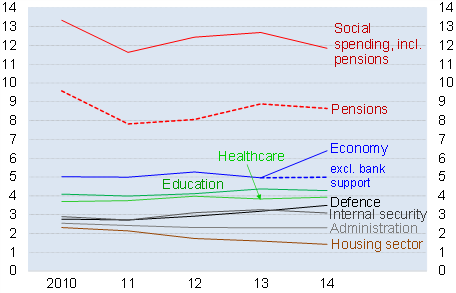BOFIT Weekly Review 10/2015
Growth of government revenues and expenditures just kept up with inflation in 2014
Revenues to the consolidated budget, that is the overall government budget (federal, regional and municipal budgets plus state social funds), increased 8 % in nominal terms. The growth rate was higher than in 2013. Nevertheless, the rate of growth was about the same as the inflation rate (average for all of 2014), meaning that revenues remained unchanged in real terms. Growth in spending slowed slightly to below 8 %. The consolidated budget deficit amounted to 1.2 % of GDP, about the same as in 2013. Revenues rose slightly to an equivalent of 37 % of GDP, while spending was unchanged at just over 38 %.
Revenues from duties and taxes on production and export of oil, petroleum products and gas caused growth in consolidated revenues to accelerate. Even if the oil price declined from 2013, the decaying ruble exchange rate boosted revenues from dollar-denominated oil taxes and duties in ruble terms. They accounted for over 28 % of consolidated budget revenues, which was greater than at any time since the 2009 recession. Nominal growth in other revenues remained below 6 %, i.e. revenues fell in real terms.
For the fourth year in a row, defence spending was increased by nearly 20 %. Defence and internal security now account for over 17 % of all spending. Spending growth slowed for pensions and other social outlays even if they were still 31 % of total spending. National economy expenditures increased sharply with the Deposit Insurance Agency’s December decision to grant large capital infusions to banks. Growth in healthcare spending kept pace with inflation, while education spending lagged.
Largest government spending categories, % of GDP

Source: Finance ministry